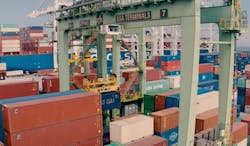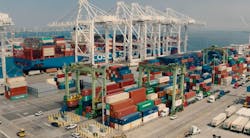SSA Marine completes Electrification of Gantry Cranes at Port of Long Beach
The Port of Long Beach is one of the busiest container shipping depots in the world and also one of the most committed to decarbonizing its operations over the next decade.
Projects to achieve this are under way from construction of a microgrid to electric vehicle charging and renewable projects.
Electrification of operations is one of the big spokes in the wheel of the Port of Long Beach’s clean energy plans. The latest in that journey is completion of the conversion of 1,000-horsepower rubber-tired gantry cranes (RTGs) from diesel-electric to 100 percent grid-tied electric at the port’s Pier J terminal.
SSA Marine completed the multi-year project converting nine ZPMC RTGs to all electric at the Pier J terminal. The multi-million-dollar project was supported by a $9.7 million grant from the California Energy Commission. Project partners include Port of Long Beach, Southern California Edison, Cavotec, and the California Energy Commission.
“SSA is thankful for the opportunity to partner with the Port of Long Beach and the California Energy Commission to complete this project,” said Scott Hainlen, superintendent at SSA Terminals. “We look forward to continuing our efforts in reducing emissions from all our operations in Long Beach.”
“SSA Marine has long been a leader in the testing and deployment of technologies to reduce emissions from maritime operations. The completion of the Pier J eRTG project is another great example of this innovative spirit and commitment to the environment,” said Ed DeNike, president of SSA Containers, in a statement.
SSA Marine is one the world’s largest privately held marine terminal operators, with activities at more than 250 terminal and rail operations.
The Port of Long Beach, combined with the nearby Port of Los Angeles, transports nearly 20 million twenty-foot equivalent units of cargo per year, according to World Shipping Council reports.
A significant increase in shipping volume pushed the Port of Long Beach’s annual greenhouse gas emissions 22 percent over 2005 levels, a recent report noted.
The facility is pursuing a number of decarbonization projects, including a clean energy microgrid for its command and control center, EV charging for on-site vehicles and commitment to the Shanghai-Los Angeles Green Shipping Corridor.
Long Beach Harbor Commission President Steven Neal previously has said that the Port of Long Beach has several environmental initiatives planned with an aim to reaching zero-emission terminal operations by 2030 and truck operations by 2035.
-- -- --
(Rod Walton, senior editor for EnergyTech, is a 14-year veteran of covering the energy industry both as a newspaper and trade journalist. He can be reached at [email protected]).
Follow us on Twitter @EnergyTechNews_ and @rodwaltonelp and on LinkedIn
About the Author
Rod Walton, EnergyTech Managing Editor
Managing Editor
For EnergyTech editorial inquiries, please contact Managing Editor Rod Walton at [email protected].
Rod Walton has spent 17 years covering the energy industry as a newspaper and trade journalist. He formerly was energy writer and business editor at the Tulsa World. Later, he spent six years covering the electricity power sector for Pennwell and Clarion Events. He joined Endeavor and EnergyTech in November 2021.
Walton earned his Bachelors degree in journalism from the University of Oklahoma. His career stops include the Moore American, Bartlesville Examiner-Enterprise, Wagoner Tribune and Tulsa World.
EnergyTech is focused on the mission critical and large-scale energy users and their sustainability and resiliency goals. These include the commercial and industrial sectors, as well as the military, universities, data centers and microgrids. The C&I sectors together account for close to 30 percent of greenhouse gas emissions in the U.S.
He was named Managing Editor for Microgrid Knowledge and EnergyTech starting July 1, 2023
Many large-scale energy users such as Fortune 500 companies, and mission-critical users such as military bases, universities, healthcare facilities, public safety and data centers, shifting their energy priorities to reach net-zero carbon goals within the coming decades. These include plans for renewable energy power purchase agreements, but also on-site resiliency projects such as microgrids, combined heat and power, rooftop solar, energy storage, digitalization and building efficiency upgrades.


